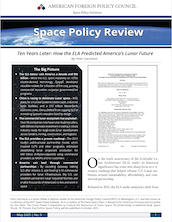Russian Policy Monitor No. 2682
Codifying Moscow's Maritime Ambitions;
Popularizing A New Imperial Vision;
The Gears of Dubious Russian Justice Grind On;
Russia's National Welath Fund at Risk
Codifying Moscow's Maritime Ambitions;
Popularizing A New Imperial Vision;
The Gears of Dubious Russian Justice Grind On;
Russia's National Welath Fund at Risk
Trump faces a pivotal moment: Capitalize on Iran’s unprecedented weakness by supporting Israel, avoiding overreach, and building bipartisan backing, or risk squandering a rare strategic advantage.

On the tenth anniversary of the Evolvable Lunar Architecture (ELA) study, its historical significance has come into sharp focus as a visionary roadmap that helped reframe U.S. Lunar ambitions around sustainability, affordability, and commercial partnership.
How Iran Made Russia's Drones More Lethal;
Iran's High-Tech Repression;
A Political Mandate For Action Against Iran;
That Old Tehran-Caracas Connection;
Iran Steps Up Its Cyber-Spying Next Door
Military Biotech Investment Needed;
Blood Vessels On Demand;
A Helium Helper for Hypersonics;
PLA Fireball Fighter Drones;
Seeking-- And Firing -- Radiation Relief